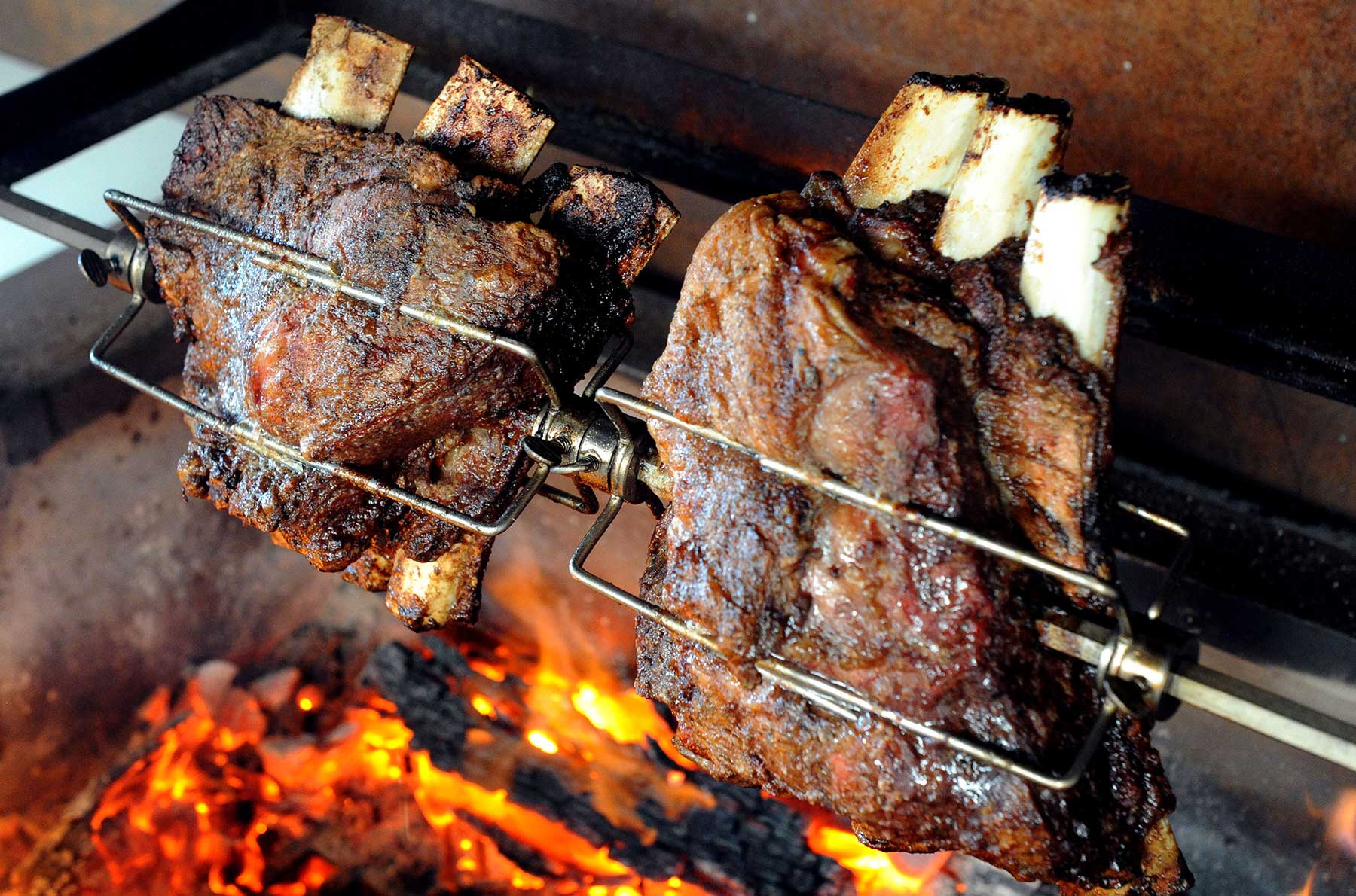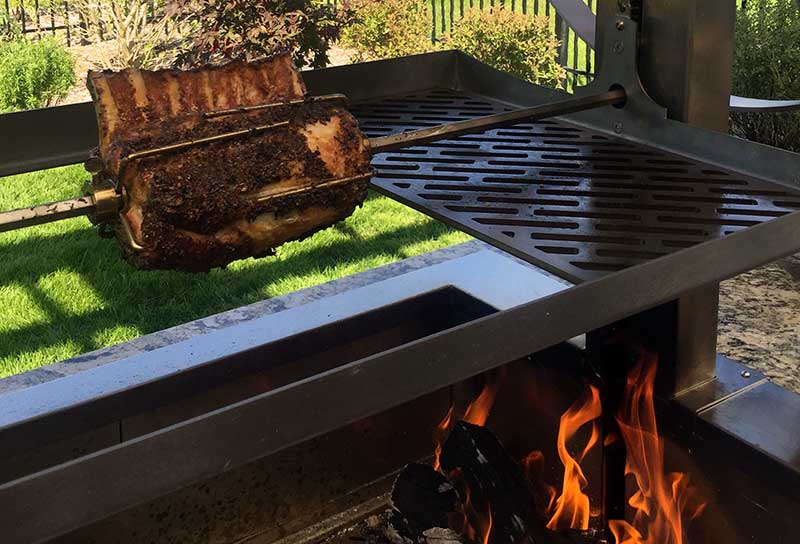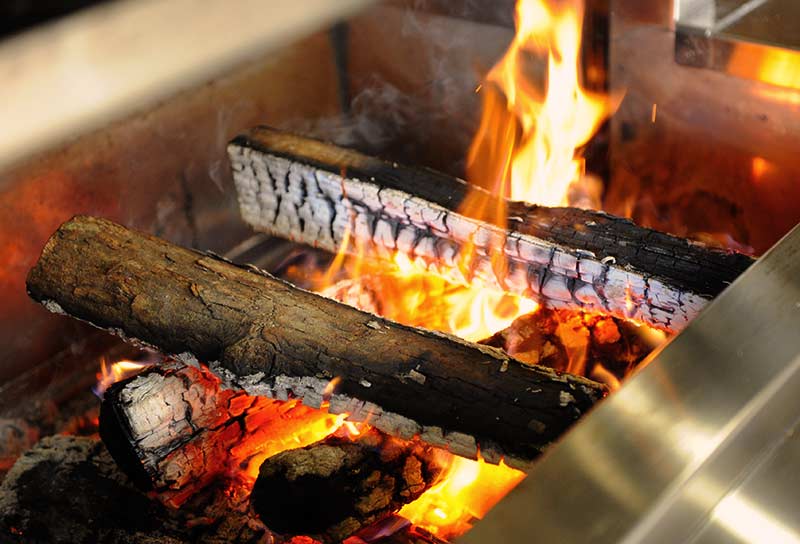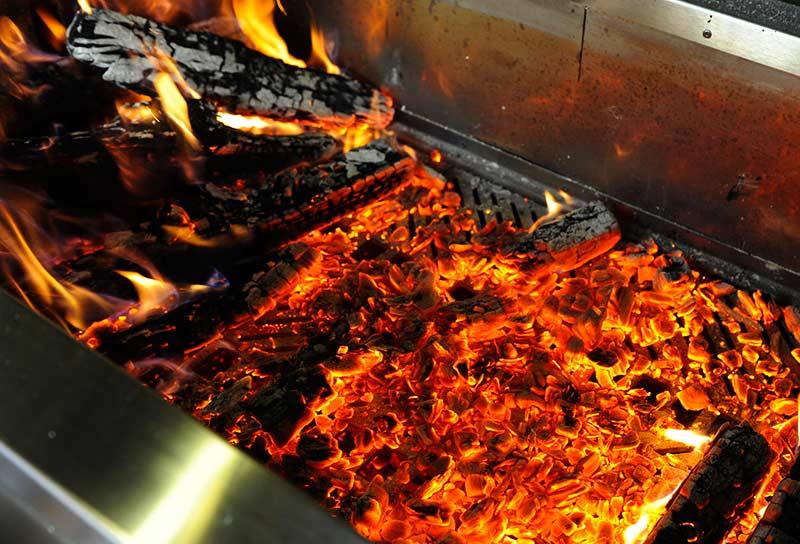
Cooking on the Argentinian-style Gaucho Grill is an experience for all the senses. The sound of the crackling fire, the heat, the aromatic smoke, and the incredible flavors of food hot off the grill – it is truly primal and immersive. This guide will teach you tips, tricks, and recipes to help you get the most enjoyment out of your Kalamazoo Gaucho Grill. Master the art of live-fire grilling and learn what makes this ancient style of cooking so satisfying.
Getting Started
The Gaucho Grill is designed to provide the ultimate primal, live-fire cooking experience – and that starts with the way you build your fire. We recommend using hardwood logs, but if you’re really in a hurry to get the fire going you can use hardwood chunks instead.
Configure your grill grates before you start the fire. If you are going to use the rotisserie, it is wise to remove the grill grate(s) necessary to make room for the spit before you start the fire. If you are leaving one or two grates in the grill to use at the same time as the rotisserie, now is also a good time to position one of the rotisserie forks on the spit. That way, when you add your food to the spit later on, you know it will be in the right position and you won’t have to make the adjustments while working above a hot fire.

Two of grill grates have been removed from the Gaucho to accommodate the Rotisserie
How to Build a Cooking Fire
Always raise the grill rack high above the firebox before building your fire. If the grill grate is too low, the flames will deposit soot on the grates (and therefore, on your food when you start grilling).
Three-Layer Fires
For most cooking sessions, we recommend a three-layer “log cabin” stack of wood, which starts quickly and cooks for a long time. As the wood is consumed and turned to embers, the fire will collapse on itself into an even layer of coals across the fire grates. The wood stack can be confined to a single area of the grill if you want to cook in just one area of the grill.
To build a three-layer fire, lay a single layer of hardwood limbs or wood splits so they run front to back on top of the fire grate, leaving a little room between each piece of wood for air circulation. Lay the next layer of wood perpendicular to the first, again leaving space for air between each piece. The third layer should be perpendicular to the second layer and in the same orientation as the first layer.

A three layer log fire in the firebox of the Gaucho Grill
Two-Layer Fires
If you are only planning on grilling for a short period and want to get the fire going faster, you can use a two-layer instead of a three-layer fire. Follow the same directions as you would for the three-layer fire, simply omitting the last layer.
Starting the Fire
Once your wood is stacked, fire up the starter burners by pressing in the REAR STARTER BURNER control knob for 5 seconds. While continuing to press in the control knob, turn it to the HIGH position. Ignition should take place within 4 to 5 seconds. If it doesn’t, turn the knob to the OFF position and wait 5 minutes for the gas to dissipate before trying again. Repeat this process to light the front starter burner, and keep the burners on for 5-10 minutes or until your fire is strong and self-sustaining. At his point you can turn the burner off.
Preparing to Cook
There is only one rule when it comes to cooking on the Gaucho Grill: clean your preheated grill grate before putting any food on the grill. We recommend using a stiff, stainless steel, brass, or wooden grill brush. Steel wool, chemicals, or any other type of grill brush should never be used on your Gaucho grill grate. We strongly recommend a pair of long insulated grilling gloves as well as long tongs. If you have two pairs of tongs available, use one for moving burning logs in the firebox and the other for handling your food.
COOKING WITH A MULTI-ZONE FIRE
To build a multi-zone fire in the Gaucho Grill you will want a strong fire on the left side furthest away from the wheel, a moderate fire in the middle and no fire at all in the right section.
By building a three-zone or multi-zone fire you can have multiple temperatures at any given height of the fire. This allows you to cook different food at the same time at different temperatures, and it allows you to move individual pieces of food around and change the temperature without having to move the whole rack.
Watch Grillmaster Russ Faulk gives his tips to building a managing a multi-zone fire in the Gaucho Grill.
Cooking With Flames
We do not recommend trying to cook over a roaring fire. When cooking over an open fire it should be a low flame that is well under control. One of our favorite heat sources to cook over is an offset fire – particularly when rotisserie roasting. To create an offset fire, use tongs to move the logs into position along the front and rear of the firebox once the fire is strong.

An offset fire in the Gaucho Grill; logs are moved to the front and rear of the firebox
Cooking Over Coals
Cooking over coals is the classic Argentinian method. Let the fire burn down until you have a bed of coals 2 to 3 inches deep; this can take an hour or more. You can always add wood, one or two pieces at a time, as needed to maintain the coals as you cook. Coals will deliver the most even heat, but the wood-fired flavor can be more subtle.

Coals in the firebox of the Gaucho Grill, ready to cook over
Managing the Fire
For long cooking sessions, dedicate one end of the grill to generating new coals. You can keep a fire going at this end by adding one or two extra splits of wood at a time. Use the burnt-down logs or glowing coals from this area to replenish your cooking fire as needed.
There are two methods for controlling the intensity of the heat as you cook:
Adjust the height of the grill grate and rotisserie spit.
Use the 30-inch spoked wheel to raise the grill grate high above the fire for lower-temperature smoke-roasting, or lower the grill rack for searing heat. We love to sear steaks and chops first and then raise the grate to continue cooking them through using a more gentle heat.Adjust the location and density of the fire.Adjust the location and density of the fire.
You can establish distinct temperature zones in the firebox of the grill by adjusting the density of the burning wood or coals under the food. This is particularly useful if you plan on grilling several types of food at the same time that require different cooking temperatures. For spit roasting on the rotisserie, we prefer to use indirect heat. To create and indirect fire, move the burning logs or hot coals to the front and rear of the firebox so that there is no direct heat below the spit. This technique can be used when cooking on the grill grates as well.
How do you know what temperature you’re cooking at? A good rule of thumb for determining your grill temperature is to hold your hand two or three inches above the grill grate; when you can hold it there for a 5-Mississippi count before pulling it away, the temperature is around 500°F. If you can keep it there longer, the temperature is lower. If you can’t stand the heat for five seconds, you’re cooking hotter.
Watch the Gaucho Grill in Action
- Tempering Steak with Grillmaster Russ Faulk
- Grilled Bone-in Ribeye Steak
- Steven Raichlen’s Prime Rib on the Gaucho Grill
- Steven Raichlen's Philly Cheesesteak on the Gaucho Grill
- Steven Raichlen’s Capetown Lamb on the Gaucho Grill
- Steven Raichlen's Spit-Roasted Beef Shoulder
A Few of our Favorite Gaucho Grill Recipes
Essential Tools
- Premium grilling gloves to keep your hands and forearms protected
- Two pairs of long grilling tongs; one to move the wood and another to handle food
- A stainless steel grill brush
- Wood – plan on about a bundle of wood per hour for long grilling sessions
- Consider custom grilling grates optimized for fish, meat, and vegetables for a superior grilling experience
- Gaucho Grill Use & Care Guide for troubleshooting, installation instructions and how-to guidance

Long tongs and a good pair of gloves are essential grilling tools
Caring for Your Gaucho Grill
Laser-cut custom grill grates should be treated like a cast iron skillets. Before using them the first time, season them by rubbing vegetable oil into the top and bottom surfaces of the grates, placing them in the grill and starting the fire. As you continue to use them, they will get darker in color and more seasoned.
Before each cooking session, once the grill is preheated, use a stiff stainless steel grill brush to clean the grilling surface.
Use a citrus-based or organic degreaser on the exterior of your Gaucho Grill. To clean up burnt-on food, we highly recommend using Bar Keepers Friend and a wet microfiber cloth – it works wonders. Follow the grain direction of the stainless steel to avoid scratches. If you do get a scratch, you can use our Scratch-B-Gone kit to restore the original finish. After cleaning, rinse off all cleaners, let the grill dry, apply stainless steel polish and wipe off with a microfiber cloth.
If you live near the ocean, your Gaucho Grill will need a little extra love to prevent rust. To keep it in optimal condition we suggest cleaning the exterior stainless steel surfaces at least twice a month to remove salt. However, should some rust spots occur, they can be easily removed with Bar Keepers Friend.

